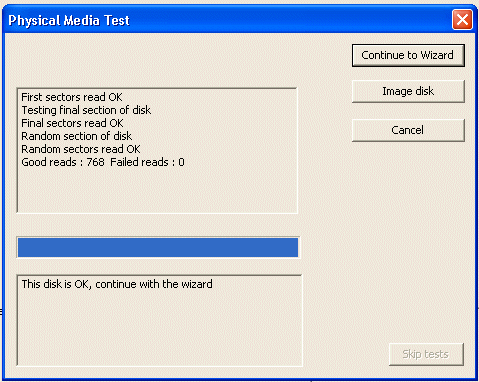|
Physical Media Test
|   |
When doing a data recovery on a hard drive it is extremely valuable to perform some basic tests on the drive to determine the best way to progress with the recovery. The Physical Media tests do this by reading different areas of the disk to try and detect if there are likely to be a significant number of failed sectors. The tests are reading from the start of the disk, the end of the disk, and then random areas of the disk.
On a good disk, the result will be shown as below which indicates that no errors where detected, and reading was fast. On this type of disk, the program will automatically continue to the Wizard
On a problem disk, there will be indications of failed sectors, or sectors that were slow to read. There should never be indications of slow reading on first and final sectors, but occasionally disks will indicate a slowness on random sectors. This is acceptable. Each test will time out after a minute, and if it does time out, this indicates that there is a physical issue with the disk.
Depending on the results, a choice can be made to image the disk first, or try a straight recovery of the data.

Continue to Wizard
This is the standard option if the physical test looks OK. If there are no more than one or two errors, and the reading is reasonably fast, then the proceeding to the wizard is the best approach. If there are too many errors detected, this option will be disabled.
On may formats, the next stage will be a quick evaluation of the disk structure.
Image Disk
If the disk is very slow to read, or has many errors the the best procedure to follow while recovering a disk is to create a disk image. By clicking on this button, the program will go directly to the disk image function.
Cancel
This will return to the Wizard entry screen
Fake memory chips
There have been several cases where data was apparently lost on a memory chip but the problem is that the memory chip is a fake chip. ie It is marked as maybe 32GB, and when formatted looks like 32GB. However, internally it only contains 4GB of memory. When written to, all looks OK until more than 4GB is written. On ones seen, the data is then wrapped around maybe just 16MB or 64MB of data area. No errors are seen on writing, but when reading back, in the example above, upto 28GB of data will be lost.
The physical media test will try and detect such chips. If found, it is just bad news. Recovery can be attempted, but expect to loose all data after the start of the physical memory.